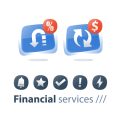1. Understanding Your Federal Student Loan Repayment Options
Choosing the right student loan repayment plan can feel overwhelming, but knowing your options is the first step to managing your debt effectively. The federal government offers several repayment plans, each designed to fit different financial situations and goals. Here’s an overview of the main federal student loan repayment plans you’ll want to consider:
Standard Repayment Plan
This is the default plan for most borrowers. Under the Standard Repayment Plan, you make fixed monthly payments over 10 years. It’s a straightforward option that helps you pay off your loans quickly and with less interest over time.
Key Features:
- Fixed monthly payments
- Loan term: 10 years
- Lowest total interest cost
- Best if you can afford higher monthly payments
Graduated Repayment Plan
If you expect your income to increase steadily over time, the Graduated Repayment Plan might be a good fit. Payments start lower and increase every two years, still paying off your loans in 10 years.
Key Features:
- Payments start low, then rise every two years
- Loan term: 10 years
- Pays more in interest than Standard Plan
- Helpful if you have a tight budget now but expect higher earnings later
Extended Repayment Plan
The Extended Repayment Plan gives you more time—up to 25 years—to pay off your loans. This means smaller monthly payments but more interest paid over time. You can choose either fixed or graduated payments with this plan.
Key Features:
- Fixed or graduated monthly payments
- Loan term: up to 25 years
- Lowers monthly payment but increases total interest cost
- Available only if you owe more than $30,000 in Direct Loans
Income-Driven Repayment Plans (IDR)
IDR plans base your monthly payment on your income and family size, making them flexible for borrowers with varying financial circumstances. There are several types of IDR plans, including REPAYE, PAYE, Income-Based Repayment (IBR), and Income-Contingent Repayment (ICR). These plans can also offer loan forgiveness after 20 or 25 years of qualifying payments.
Key Features:
- Monthly payment is a percentage of discretionary income
- Loan term: 20–25 years before potential forgiveness
- Helps keep payments affordable if you have lower income or high debt
- You may pay more in interest overall compared to other plans
Comparison Table of Federal Student Loan Repayment Plans
| Repayment Plan | Payment Amount | Repayment Period | Main Benefit |
|---|---|---|---|
| Standard Repayment | Fixed payments | 10 years | Pays off debt quickly; lowest total interest cost |
| Graduated Repayment | Payments increase every two years | 10 years | Lower initial payments; good for expected income growth |
| Extended Repayment | Fixed or graduated payments | Up to 25 years | Lowers monthly payments; good for large loan balances |
| IDR Plans (REPAYE, PAYE, IBR, ICR) | % of discretionary income | 20–25 years before forgiveness possible | Keeps payments affordable; forgiveness option after many years of payments |
Selecting the right repayment plan depends on your current financial situation, career goals, and how much flexibility you need. Understanding these options will help you make smart choices as you move forward with repaying your student loans.
2. Assessing Your Financial Situation
Why Understanding Your Finances Matters
Before picking a student loan repayment plan, it’s important to get a clear picture of your financial situation. Knowing how much you earn, spend, and save can help you choose the plan that fits your lifestyle and long-term goals. Let’s break down how to evaluate your income, budget, and future plans.
Calculating Your Monthly Income
Your monthly income is the money you actually take home after taxes and deductions. This includes your salary, side hustles, or any other regular cash flow. Use the table below to organize your sources:
| Income Source | Amount (After Taxes) |
|---|---|
| Main Job | $_______ |
| Part-Time/Side Hustle | $_______ |
| Other (e.g., support, freelance) | $_______ |
| Total Monthly Income | $_______ |
Creating a Realistic Budget
List all of your monthly expenses—think rent, groceries, utilities, transportation, insurance, entertainment, and savings. Subtract these from your total monthly income to see what’s left for student loan payments. Here’s an easy way to track:
| Expense Category | Monthly Amount |
|---|---|
| Rent/Mortgage | $_______ |
| Utilities & Internet | $_______ |
| Groceries & Food | $_______ |
| Transportation (Gas/Transit) | $_______ |
| Insurance (Health/Auto) | $_______ |
| Entertainment & Eating Out | $_______ |
| Savings/Investments | $_______ |
| Other Expenses (Phone, Subscriptions) | $_______ |
| Total Monthly Expenses | $_______ |
| Money Left for Loan Payment (Income – Expenses) |
$_______ |
Thinking About Long-Term Financial Goals
Your repayment plan should fit not just your current budget but also your future plans. Ask yourself:
- Do you want to buy a house soon?
- Are you planning on starting a family?
- Is saving for retirement a top priority?
If you need more flexibility now but expect your income to rise later, an income-driven repayment plan could be a good fit. If you want to pay off your loans quickly to save on interest, a standard repayment plan might work better.
Quick Checklist for Evaluating Your Situation:
- Add up all your sources of income.
- Total up all monthly expenses.
- Figure out how much you can realistically afford for loan payments each month.
- Consider how different repayment plans impact your long-term financial goals.
Bottom Line:
The right student loan repayment plan depends on knowing where you stand financially right now and where you hope to go in the future. Take time to crunch the numbers before making a decision that will stick with you for years.

3. Weighing the Pros and Cons of Each Plan
When it comes to choosing a student loan repayment plan, it’s important to compare your options carefully. Each plan has unique advantages and disadvantages that can impact your monthly budget, the total interest you pay, and whether you might qualify for loan forgiveness programs. Let’s break down the key factors to consider.
Comparing Repayment Plans: What Matters Most?
Here are the main aspects you should look at when evaluating student loan repayment plans:
- Total Interest Paid: How much will you pay over the life of the loan?
- Monthly Payment Size: Can you comfortably afford the payment each month?
- Loan Forgiveness Eligibility: Will you qualify for any programs that cancel your debt after a set period?
Side-by-Side Comparison of Repayment Plans
| Repayment Plan | Monthly Payment | Total Interest Paid | Forgiveness Option | Best For |
|---|---|---|---|---|
| Standard Repayment | Higher (fixed) | Lowest overall | No | Borrowers who want to pay off loans quickly |
| Graduated Repayment | Starts low, increases every 2 years | More than standard plan | No | Borrowers expecting income to rise over time |
| Extended Repayment | Lower (fixed or graduated) | Higher due to longer term | No | Bigger loan balances needing lower payments now |
| Income-Driven Repayment (IDR) | Based on income and family size | Varies; may be higher if repaid slowly | Yes (after 20-25 years) | Borrowers with low income or seeking forgiveness |
| Public Service Loan Forgiveness (PSLF) | IDR required; depends on income | May pay less if forgiven early | Yes (after 10 years in public service) | Borrowers working in government/nonprofit jobs |
The Upsides and Downsides in Plain English
- Standard Plan: Pays off loans fastest with the least interest, but monthly payments can be tough for new grads.
- Graduated Plan: Payments start low and increase—helpful if you expect raises but could get expensive later.
- Extended Plan: Spreads payments out up to 25 years for smaller monthly bills, but you’ll pay more interest overall.
- IDR Plans: Flexible based on what you earn. Payments could be very low, and forgiveness is possible—but interest can add up if you pay slowly.
- PSLF: Great if you work in public service—loan balance can be wiped out after 10 years, but strict rules apply.
Your Next Steps: Prioritize Your Needs
The best plan for you depends on your current financial situation and future goals. If keeping monthly costs low is most important right now, an IDR or extended plan could help. If paying off your loan as fast as possible is your priority—and you can handle higher payments—the standard plan saves money in the long run. And don’t forget about forgiveness programs if you’re eligible! Understanding these pros and cons makes it easier to pick a plan that fits your life.
4. Considering Private Loan Repayment Strategies
When it comes to repaying private student loans, your options are often different from those available for federal loans. Private lenders set their own terms, so its important to know what strategies you can use to manage your loan and protect your financial health.
Understanding Your Private Loan Repayment Options
Unlike federal loans, private student loans don’t usually offer income-driven repayment plans or public service loan forgiveness. However, most private lenders provide some flexibility. Here are the main options you might encounter:
| Repayment Option | Description | Things to Consider |
|---|---|---|
| Standard Repayment | Fixed monthly payments over a set term (usually 5-20 years) | Predictable but may have higher payments compared to other plans |
| Interest-Only Payments | Pay only interest for a period, then full payments later | Lower initial payments but higher total cost in the end |
| Graduated Repayment | Payments start lower and increase over time | Makes sense if you expect your income to rise steadily |
| Deferment or Forbearance | Temporarily pause or reduce payments during hardship | Interest usually continues to accrue, increasing your total debt |
| Refinancing | Replace one or more loans with a new private loan at a potentially lower rate | You’ll need good credit; refinancing federal loans means losing government benefits like forgiveness or deferment options |
Lender-Specific Plans and Programs
Each lender may offer unique repayment assistance programs. Some have hardship assistance or flexible payment plans tailored for recent grads or those facing unemployment. Always check with your lender directly and ask about any special programs they offer—you might find an option that fits your current situation better than standard plans.
The Impact on Your Credit Score
Your payment history is a key part of your credit score in the U.S. Missing payments or defaulting on your loan can seriously damage your credit, making it harder to rent an apartment, get a car loan, or even secure certain jobs. On the flip side, consistently making on-time payments will help build positive credit history.
| Action Taken | Potential Impact on Credit Score |
|---|---|
| On-time monthly payments | Positive impact; builds good credit history over time |
| Missed or late payments | Negative impact; can lower score and lead to collection activity |
| Refinancing with a hard credit check | Slight temporary dip due to inquiry, but long-term benefit if payments are managed well after refinancing |
| Loan default or charge-off | Severe negative impact; stays on report for up to 7 years |
Tips for Managing Private Student Loans Effectively:
- Create a budget that includes your monthly loan payments.
- If you’re struggling, reach out to your lender before missing a payment—they may be able to help.
- Avoid refinancing federal loans into private ones unless you’re sure you won’t need federal protections.
- Set up autopay if possible—many lenders offer small interest rate discounts for automatic payments.
Understanding all your options helps you make smart decisions about managing private student loan debt and staying on top of your finances as you move forward in life.
5. Steps to Switch or Apply for a New Repayment Plan
If you’ve decided that your current student loan repayment plan isn’t the best fit, don’t worry—switching plans or applying for a new one is straightforward. Here’s a step-by-step guide to help you through the process.
Contact Your Loan Servicer
Your first step is always reaching out to your loan servicer—the company that manages your student loan account. You can find their contact information on your monthly statement or by logging into your federal student aid account at studentaid.gov. Your servicer can answer questions, explain your options, and start the application process with you.
Gather Necessary Documentation
You’ll need some basic information and documents to apply for or switch repayment plans. Here’s what you should have ready:
| Item | Why It’s Needed |
|---|---|
| Federal Student Aid (FSA) ID | To access and update your loan details online |
| Recent pay stubs or tax returns | For income-driven repayment (IDR) plans, to verify your income |
| Loan account number(s) | To ensure changes apply to the right loans |
| Personal identification (e.g., Social Security Number) | For identity verification |
Select the Right Repayment Plan
Your servicer can help you compare available plans, but it helps to know what you want. Are you looking to lower your monthly payments? Pay off your loans faster? Qualify for Public Service Loan Forgiveness? Make sure you clearly communicate your financial goals.
Main Types of Repayment Plans
| Plan Type | Best For |
|---|---|
| Standard Repayment Plan | Payers who want predictable payments and fast payoff (10 years) |
| Graduated Repayment Plan | Payers expecting their income to increase over time |
| Extended Repayment Plan | Payers needing lower monthly payments over a longer period (up to 25 years) |
| Income-Driven Repayment (IDR) Plans | Payers with limited income or seeking forgiveness options |
Apply Online or By Mail
The fastest way is usually online via studentaid.gov, where you can submit an application for income-driven plans directly. Alternatively, your servicer can send you paper forms if you prefer mail. Follow all instructions carefully, attach documentation if needed, and double-check for accuracy.
What Happens Next?
- Your servicer will review your application and may ask for more information.
- If switching to an IDR plan, you might need to recertify your income every year.
- You’ll receive a notice about when your new plan starts and what your updated payments will be.
- If youre in deferment or forbearance, switching plans won’t automatically lift those holds—ask your servicer how it affects your status.
Troubleshooting Tips
- If you’re unsure which plan is best, use the federal government’s Loan Simulator tool.
- If you miss paperwork or deadlines, don’t panic—just contact your servicer as soon as possible.
- You can change plans again in the future if your financial situation changes.
This process ensures you’re set up with a repayment plan that matches both your budget and long-term goals. Don’t hesitate to reach out for help—you’re not alone in this journey!


